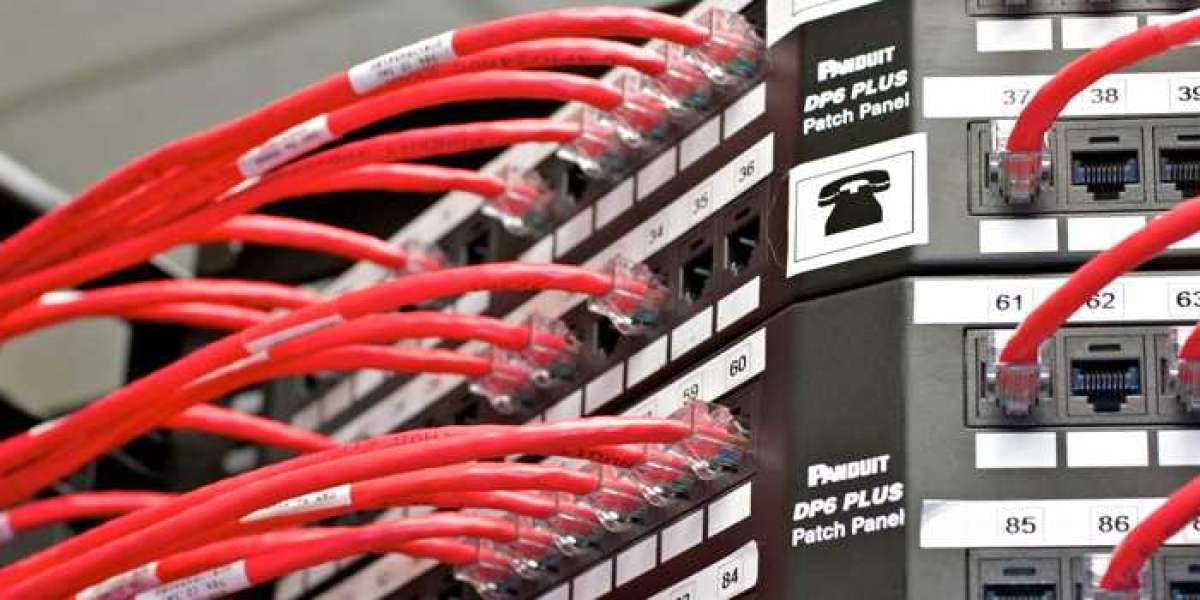At AppsComm Technologies LLC, we understand the importance of a solid foundation for communication infrastructure. Whether you’re building a new office, upgrading an existing setup, or expanding your data network, structured cabling and networking solutions offer the reliability and flexibility needed to meet modern demands.

What is Structured Cabling?
Structured cabling refers to an organized system of cables and related hardware designed to support multiple voice, data, video, and multimedia systems within a building or across a campus. Unlike traditional, point-to-point cabling that links specific devices, structured cabling follows a standardized approach that organizes the entire infrastructure for ease of maintenance, expansion, and troubleshooting. It serves as the backbone of any modern communication network, facilitating seamless connectivity and communication across a wide range of applications.
Structured cabling includes various components, including cable types, patch panels, network switches, racks, and distribution frames. These components are designed to work together efficiently, ensuring minimal downtime and optimal performance. A well-designed structured cabling system can reduce network failures, improve system performance, and make it easier to upgrade or reconfigure your network in the future.
The Importance of Structured Cabling
The need for a structured cabling system has grown as businesses increasingly rely on technology to operate. A robust and scalable cabling solution is essential for several reasons:
- Improved Network Performance: Structured cabling reduces the risk of network failures and slowdowns. With a carefully planned infrastructure, data can flow quickly and efficiently, ensuring high-speed connectivity for all users.
- Future-Proofing: As businesses grow and technology advances, structured cabling allows for easy upgrades. The system can be designed to handle future bandwidth requirements, ensuring that your network remains relevant and capable of supporting new technologies.
- Cost-Effectiveness: By centralizing and organizing the cabling infrastructure, structured cabling systems reduce the need for ongoing maintenance and troubleshooting. This can save businesses significant time and money over the long term.
- Simplified Troubleshooting and Maintenance: When your cables are organized and labeled, troubleshooting becomes faster and more efficient. This helps to minimize downtime and the costs associated with repairs and maintenance.
- Scalability: Structured cabling systems are designed to grow with your business. Whether you’re adding new offices or upgrading your equipment, your infrastructure can easily accommodate future changes without requiring a major overhaul.
- Aesthetic and Safety Benefits: A well-organized cabling system not only looks more professional but also reduces the risks associated with poorly managed cables, such as electrical hazards, tangles, or tripping accidents.
Key Components of Structured Cabling
To understand structured cabling in depth, it’s important to look at its various components. Each part plays a crucial role in ensuring optimal network functionality:
- Cabling: The core of the system, these cables are responsible for transmitting data across the network. Common types of cabling used in structured cabling systems include:
- Cat5e and Cat6 Ethernet cables: These are commonly used for high-speed data transmission, providing excellent bandwidth and speed for most networking applications.
- Fiber Optic Cables: For businesses that require extremely high-speed connections and long-distance transmission, fiber optic cables provide the best solution due to their high bandwidth and low latency.
- Patch Panels: Patch panels are used to manage and organize network cables. They allow for easier cable management and make it simpler to connect various network components, such as switches, routers, and servers, to one another.
- Racks and Cabinets: These are used to house network equipment such as switches, routers, servers, and patch panels. They provide an organized and secure way to manage equipment and cabling, ensuring everything is easy to access and maintain.
- Cable Management Accessories: To maintain the order and structure of the cabling system, various accessories like cable ties, cable trays, and Velcro straps are used. These help to keep cables neat and prevent them from tangling, which could lead to potential issues or downtime.
- Connectors and Jacks: These components connect different parts of the cabling system, allowing seamless communication between devices. This includes connectors such as RJ45 connectors, fiber optic connectors, and keystone jacks.
- Cross-Connects: Cross-connects are used to physically link different parts of the network. For example, they can connect the main server room to other areas of a building or campus.
- Networking Equipment: This includes switches, routers, and servers that distribute and route data between devices across the network. Proper integration with structured cabling is critical for ensuring optimal network performance.
Networking: The Role of Structured Cabling in Building Reliable Networks
Structured cabling lays the groundwork for all networking operations. By establishing a well-organized system for cables, connectors, and equipment, businesses can ensure that their network infrastructure operates at peak performance.
When designing a network, several factors need to be considered, including bandwidth requirements, the physical layout of the space, and the potential for future expansion. Structured cabling allows for the flexible implementation of different types of networks, including Local Area Networks (LAN), Wide Area Networks (WAN), and wireless networks.
Key benefits of structured cabling in networking include:
- High-Speed Data Transmission: A structured cabling system ensures that data flows without interruptions, offering the high bandwidth necessary for modern applications like video conferencing, cloud services, and high-definition content streaming.
- Centralized Network Management: With structured cabling, businesses can centralize their networking equipment and simplify their management. By organizing devices and connections within dedicated racks or cabinets, network administrators can more efficiently manage and monitor the network.
- Security: A properly organized cabling system ensures that the network remains secure. By limiting access to critical components and properly managing cables, businesses can reduce the risk of security breaches caused by physical vulnerabilities.
- Flexibility and Scalability: Structured cabling supports scalability by allowing businesses to easily add or remove devices and equipment as their needs change. Adding new connections, network switches, or devices can be done without major disruptions to the existing system.
- Reduced Downtime: In the event of a network failure, a well-structured system simplifies troubleshooting. Identifying and resolving issues is faster and more efficient, minimizing downtime and the impact on operations.
Structured Cabling vs. Traditional Cabling: Why Choose Structured?
Many businesses still use outdated cabling systems that follow traditional point-to-point wiring methods. While these systems may work for smaller setups, they present several issues as businesses scale.
Here’s why structured cabling is a better option compared to traditional cabling systems:
- Organization and Scalability: Traditional cabling can become messy and difficult to manage as networks expand. In contrast, structured cabling organizes all components into a cohesive system, making it much easier to scale and maintain.
- Future-Proofing: Traditional cabling systems often lack the flexibility to accommodate new technologies, whereas structured cabling is designed with future growth in mind, allowing for quick upgrades as technology evolves.
- Minimized Downtime: With a structured system, diagnosing and repairing network issues becomes easier and quicker, ensuring minimal disruption to business operations.
Why Choose AppsComm Technologies LLC for Your Structured Cabling and Networking Needs?
At AppsComm Technologies LLC, we are committed to providing top-tier structured cabling and networking solutions tailored to your specific needs. Our expert team understands the complexities of modern communication systems and ensures that every cabling project is done with precision and care.
Why work with us?
- Expertise and Experience: With years of experience in the field, we bring deep knowledge of the latest industry standards and technologies. Whether you’re upgrading an existing system or implementing a new one, we ensure that your infrastructure is future-proof and optimized for peak performance.
- Tailored Solutions: Every business is different, and so are their networking needs. We provide customized solutions that are specifically designed to meet your unique requirements, from small businesses to large enterprises.
- High-Quality Materials: We use only the best materials and equipment to build reliable, long-lasting cabling systems that deliver high performance.
- Seamless Integration: Our structured cabling systems are fully integrated with the latest networking technologies, ensuring your entire infrastructure works harmoniously.
- Comprehensive Support: Our support doesn’t end with installation. We provide ongoing maintenance, troubleshooting, and upgrades, helping you keep your network running smoothly for years to come.
Conclusion
Structured cabling and networking are the foundation of modern communication systems. By investing in a well-organized and scalable cabling infrastructure, businesses can enhance network performance, minimize downtime, and ensure that their network is ready for future growth. At AppsComm Technologies LLC, we specialize in providing comprehensive structured cabling and networking solutions that cater to your specific needs, ensuring reliable, secure, and efficient communication systems for your business.
Let us help you build the backbone of your network today — contact us for a consultation!



